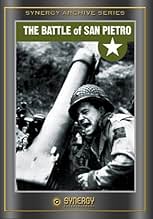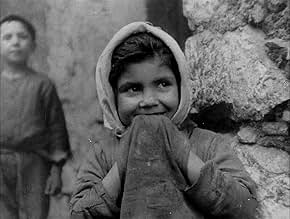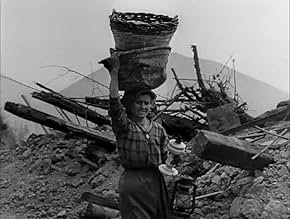IMDb-BEWERTUNG
6,6/10
2589
IHRE BEWERTUNG
Füge eine Handlung in deiner Sprache hinzuDirector John Huston documents the Battle of San Pietro Infine in December 1943.Director John Huston documents the Battle of San Pietro Infine in December 1943.Director John Huston documents the Battle of San Pietro Infine in December 1943.
- Regie
- Drehbuch
- Hauptbesetzung
- Auszeichnungen
- 1 wins total
Mark W. Clark
- Self - Introduction
- (Nicht genannt)
John Huston
- Narrator
- (Synchronisation)
- (Nicht genannt)
Empfohlene Bewertungen
One reviewer commented that he didn't know how this film ever got released during World War II. It almost didn't.
First, you need to know that Hollywood actors, directors and producers were heavily recruited by the War and Navy Departments (the Defense Dept. is a post war innovation). These celebrities got to know a lot of the senior military personnel through their activities in Stage Door Canteens, the USO, recruiting and bond drives. Few were closer to the military top brass than Orson Welles, a close friend of Houston's.
Welles told this story on, I believe, a Dick Cavett Show in the late 1960s or very early 1970s. I repeat it as I remember it.
According to Welles the War Department censors did not want San Pietro released. They felt that the film was too graphic and that it might have an adverse effect on support for the war. Through Welles' personal friendship with General George C. Marshall he and Houston arranged a private screening at the Pentagon for Marshall, his staff and the censors. Following the screening Gen. Marshall stood up and ordered that the film be released. He said that it was an accurate depiction and that war was horrible. He felt that the American people needed to know that horror lest they romanticize war and become fond of a monstrous act of inhumanity.
So San Pietro was released. If Welles exaggerated his role, I can't say. Certainly Houston didn't contradict him. If I have misremembered the tale in some particular, it does not change the fact that San Pietro owed its release to the intervention of Marshall.
Even today San Pietro is worth seeing. As has already been suggested, it is a good complement to Lewis Milestone's All Quiet on the Western Front. I would suggest that it also ranks with two other great movies whose subject is World War I. Those movies are Jean Renoir's Grand Illusion and Stanley Kubrick's Paths of Glory. And, although it doesn't quiet rank with the three films already mentioned, Philippe de Broca's King of Hearts belongs in the insanity of war film festival we seem to be constructing here. Finally, I would point out that earlier wars are often stand ins for the more recent one as in M.A.S.H. Korea stood in for Vietnam.
First, you need to know that Hollywood actors, directors and producers were heavily recruited by the War and Navy Departments (the Defense Dept. is a post war innovation). These celebrities got to know a lot of the senior military personnel through their activities in Stage Door Canteens, the USO, recruiting and bond drives. Few were closer to the military top brass than Orson Welles, a close friend of Houston's.
Welles told this story on, I believe, a Dick Cavett Show in the late 1960s or very early 1970s. I repeat it as I remember it.
According to Welles the War Department censors did not want San Pietro released. They felt that the film was too graphic and that it might have an adverse effect on support for the war. Through Welles' personal friendship with General George C. Marshall he and Houston arranged a private screening at the Pentagon for Marshall, his staff and the censors. Following the screening Gen. Marshall stood up and ordered that the film be released. He said that it was an accurate depiction and that war was horrible. He felt that the American people needed to know that horror lest they romanticize war and become fond of a monstrous act of inhumanity.
So San Pietro was released. If Welles exaggerated his role, I can't say. Certainly Houston didn't contradict him. If I have misremembered the tale in some particular, it does not change the fact that San Pietro owed its release to the intervention of Marshall.
Even today San Pietro is worth seeing. As has already been suggested, it is a good complement to Lewis Milestone's All Quiet on the Western Front. I would suggest that it also ranks with two other great movies whose subject is World War I. Those movies are Jean Renoir's Grand Illusion and Stanley Kubrick's Paths of Glory. And, although it doesn't quiet rank with the three films already mentioned, Philippe de Broca's King of Hearts belongs in the insanity of war film festival we seem to be constructing here. Finally, I would point out that earlier wars are often stand ins for the more recent one as in M.A.S.H. Korea stood in for Vietnam.
I was expecting quite a bit from this movie, as it's often being credited as being an intriguing WW II (anti)war documentary, that puts you right in the middle of things. It does feature some unique and straight-forward battle images but to me it just didn't all worked out.
To me this movie looks and feels more like a news reel than an actual documentary about the accounts of the battle of San Pietro. This might sound like a compliment but it isn't really. The movie tells a story and it features lots of footage but it all feels glued together. To me it's even doubtful if the narration and images even belong together. The entire narration tells how the battle progressed but I doubted that all of the footage got shot during any of those talked about events. My suspicion got confirmed by the end of the movie, when a disclaimer got shown saying some of the footage got shot before and after the battle but were put into the movie for continuity reasons.
The narration by John Huston keeps the movie going at all times but it makes things happen a bit too fast as well really. Guess this is not the creator's fault but more the war department's that heavily cut the movie down because the movie got considered to be too anti-war by them.
The movie is mostly considered to be anti-war because it's being pretty straight-forward and of course honest. You'll see death bodies in this movie and allies taking some heavy blows by the Nazi-enemy. This of course however this present day only works out as realistic and more interesting as well.
After watching this movie I still don't feel like I knew what happened all during the battle of San Pietro, or why this battle was considered to be such a distinctive or important one to the allied campaign. But this again is also mostly due to the movie its too high pace.
WW II-buffs will still 'enjoy' this movie for what it is, due to its unique footage but don't expect to learn much or to be blown away by any of the movie its images.
6/10
http://bobafett1138.blogspot.com/
To me this movie looks and feels more like a news reel than an actual documentary about the accounts of the battle of San Pietro. This might sound like a compliment but it isn't really. The movie tells a story and it features lots of footage but it all feels glued together. To me it's even doubtful if the narration and images even belong together. The entire narration tells how the battle progressed but I doubted that all of the footage got shot during any of those talked about events. My suspicion got confirmed by the end of the movie, when a disclaimer got shown saying some of the footage got shot before and after the battle but were put into the movie for continuity reasons.
The narration by John Huston keeps the movie going at all times but it makes things happen a bit too fast as well really. Guess this is not the creator's fault but more the war department's that heavily cut the movie down because the movie got considered to be too anti-war by them.
The movie is mostly considered to be anti-war because it's being pretty straight-forward and of course honest. You'll see death bodies in this movie and allies taking some heavy blows by the Nazi-enemy. This of course however this present day only works out as realistic and more interesting as well.
After watching this movie I still don't feel like I knew what happened all during the battle of San Pietro, or why this battle was considered to be such a distinctive or important one to the allied campaign. But this again is also mostly due to the movie its too high pace.
WW II-buffs will still 'enjoy' this movie for what it is, due to its unique footage but don't expect to learn much or to be blown away by any of the movie its images.
6/10
http://bobafett1138.blogspot.com/
i recently saw the approx. 40min version of this film and i must say, knowing what is missing from the 32min version, that it is indeed far more impactful and superior. images of more fallen soldiers in white body bags appear and reappear throughout to the point of it being a reocurring theme. i'm sure it's just as brilliant without the extra footage, but if you can, try to see the extra footage. while i have not seen the true original (running approx. 50min), i'm quite positive it's even better than the one i was fortunate enough to see. a great documentary film all-around (even if some of it was staged).
While I agree with another reviewer here that " All Quiet On The Western Front" is one of the greatest anti-war films of all time I don't see this documentary as anti-war at all. San Pietro was of strategic value to the Allied Forces and yes we took it at great loss of life and yes nobody wants to die in some war in a foreign country but these brave young men died for a good cause. To try and use this film to argue that wars should never be fought does a great disservice to all the young Americans who died to free Europe from the Nazis.
John Huston's World War II documentary on the battle of San Pietro is easily up to the high standard that he set with his numerous classic dramas. It is impressive in describing both the events and the atmosphere of a desperate and costly struggle, and it is memorable in preserving its effect on those who had to live through it.
Even on a purely historical level, this would serve as a valuable description of one stage in the grueling Italian campaign, one of the war's least-remembered and least glamorous aspects. The narration is very efficient in detailing what the battle was about, what happened, and why it happened. It puts everything into the perspective of the war as a whole, and it also provides a look at the nature of the Allies' slow, grueling, costly progress up the Italian peninsula.
On a dramatic level, it is even more effective and memorable. Without forcing anything, without resorting to ploys of any kind, it brings you into the world of the unfortunate foot soldiers on whose backs and blood the fate of the battle rested. Huston's narration is flawless, using evenly measured tones to describe events in such a way as to allow them and the pictures of them to speak for themselves - and they speak in a powerful way.
Most of the footage must have been taken at considerable risk, and while there is nothing fancy about the techniques, it's impressive how much it captures. The soldiers slowly crawling along rocky heights, the pounding of heavy artillery, the frightened civilians hiding in caves, and much more, are all vividly captured. It's hard to think of another documentary then or now that succeeds so well at what it set out to do.
Even on a purely historical level, this would serve as a valuable description of one stage in the grueling Italian campaign, one of the war's least-remembered and least glamorous aspects. The narration is very efficient in detailing what the battle was about, what happened, and why it happened. It puts everything into the perspective of the war as a whole, and it also provides a look at the nature of the Allies' slow, grueling, costly progress up the Italian peninsula.
On a dramatic level, it is even more effective and memorable. Without forcing anything, without resorting to ploys of any kind, it brings you into the world of the unfortunate foot soldiers on whose backs and blood the fate of the battle rested. Huston's narration is flawless, using evenly measured tones to describe events in such a way as to allow them and the pictures of them to speak for themselves - and they speak in a powerful way.
Most of the footage must have been taken at considerable risk, and while there is nothing fancy about the techniques, it's impressive how much it captures. The soldiers slowly crawling along rocky heights, the pounding of heavy artillery, the frightened civilians hiding in caves, and much more, are all vividly captured. It's hard to think of another documentary then or now that succeeds so well at what it set out to do.
Wusstest du schon
- WissenswertesThis film was considered so blunt in its depiction of the difficulties of the battle that the US Army refused to show it, believing it to be damaging to troop morale.
- VerbindungenEdited into Schlachtgewitter am Monte Cassino (1945)
Top-Auswahl
Melde dich zum Bewerten an und greife auf die Watchlist für personalisierte Empfehlungen zu.
Details
- Laufzeit32 Minuten
- Farbe
- Sound-Mix
- Seitenverhältnis
- 1.37 : 1
Zu dieser Seite beitragen
Bearbeitung vorschlagen oder fehlenden Inhalt hinzufügen






















